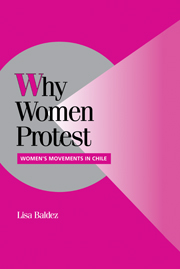Book contents
- Frontmatter
- Contents
- List of Figures and Tables
- Preface
- 1 WHY WOMEN PROTEST: TIPPING, TIMING, AND FRAMING
- 2 MOTHERS OF THE COLD WAR, DAUGHTERS OF THE REVOLUTION: A HISTORICAL OVERVIEW OF WOMEN AND CHILEAN POLITICS
- Part One Women Against Allende
- 3 THE REVOLUTION HITS HOME: WOMEN ORGANIZE AGAINST ALLENDE
- 4 CATAPULTING MEN TO ACTION: THE MARCH OF THE EMPTY POTS
- 5 “FEMININE POWER” AND THE END OF THE SOCIALIST REVOLUTION
- Part Two Women Against Pinochet
- References
- Index
5 - “FEMININE POWER” AND THE END OF THE SOCIALIST REVOLUTION
Published online by Cambridge University Press: 06 July 2010
- Frontmatter
- Contents
- List of Figures and Tables
- Preface
- 1 WHY WOMEN PROTEST: TIPPING, TIMING, AND FRAMING
- 2 MOTHERS OF THE COLD WAR, DAUGHTERS OF THE REVOLUTION: A HISTORICAL OVERVIEW OF WOMEN AND CHILEAN POLITICS
- Part One Women Against Allende
- 3 THE REVOLUTION HITS HOME: WOMEN ORGANIZE AGAINST ALLENDE
- 4 CATAPULTING MEN TO ACTION: THE MARCH OF THE EMPTY POTS
- 5 “FEMININE POWER” AND THE END OF THE SOCIALIST REVOLUTION
- Part Two Women Against Pinochet
- References
- Index
Summary
The breakdown of democracy in Chile has been explained in terms of class divisions (Stallings 1978), U.S. government intervention (Petras and Morley 1974), partisan conflict (Sigmund 1977; Valenzuela 1978; Valenzuela and Valenzuela 1986), and institutional design (Taagepera and Shugart 1989; Shugart and Carey 1992). None of these accounts has discussed the relevance of gender differences – yet many of Chile's political battles were fought in terms of gender. In the period that followed the March of the Empty Pots, politicians in the government and the opposition alike framed many important events in gendered terms. They competed with one another to claim “feminine power” on their behalf. They did so largely in anticipation of the 1973 congressional elections, which would be closely contested and in which women's votes would likely determine the outcome.
At the same time, female leaders both within and outside the parties sought to sustain women's mobilization and to consolidate their leverage over policy outcomes. Women took advantage of political instability to promote policies they cared about as well as to forward their own careers in the parties and in Congress. They succeeded in doing so to a then unprecedented degree: in 1973, female candidates won 14 of the 150 seats in the House of Deputies, or 9.3 percent. Unfortunately, the coup cut short women's opportunities to translate their electoral clout into policy change. Once in power, Pinochet took over the women's movement, retooling it to suit his own purposes.
- Type
- Chapter
- Information
- Why Women ProtestWomen's Movements in Chile, pp. 98 - 122Publisher: Cambridge University PressPrint publication year: 2002

